Golden Triangle Virtual Challenge
On 1st December 2023, I started a new virtual Kickbiking challenge – the Golden Triangle in India. India’s Golden Triangle is a tourist circuit that connects New Delhi, India’s national capital city, with Agra and Jaipur. It is called “The Golden Triangle” because it’s route is triangular shape when shown on a map. Usually the journey starts in Delhi, it then heads south to the site of the Taj Mahal at Agra in Uttar Pradesh state, then heads west, to Jaipur in the desert landscapes of Rajasthan state. It is possible to do the trip by road, train or plane and is now a popular route, giving a good spectrum of the country’s different landscapes. This challenge was done through The Conqueror Challenges, like other Kickbike virtual challenges I’ve done over the last few years. I allowed myself 3 months to complete the challenge.
The postcards are from The Conqueror Challenges emails I received at various times during the challenge, and textual information is about the various places is based on information in the postcard emails received during the challenge and other websites.
1st December 2023 – New Delhi & Red Fort
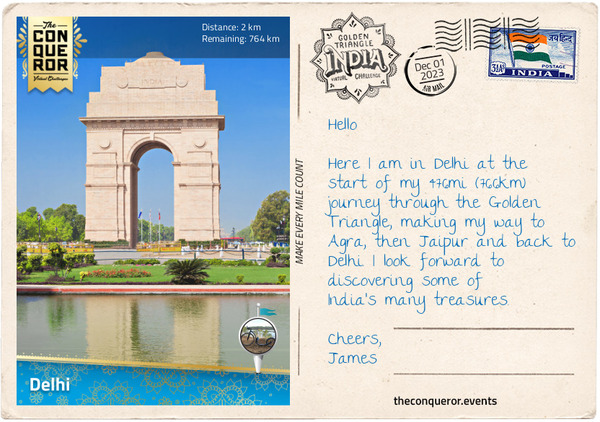
India is surrounded on 3 sides by ocean, with the Indian Ocean to it’s south, the Arabian Sea to it’s west, the Bay of Bengal to it’s east, and large island of Sri Lanka off it’s south eastern coastline. The country is home to the Thar Desert which is in the state of Rajastan, and the Ganges River, a sacred river that also travels through Bangladesh. The people are India diverse, with various cultures, traditions, religions, foods and languages represented. Visually their clothes, festivals, art and decorations are very colourful. Various aromatic spices add an olfactory element to a visit there.
Over the centuries India has been invaded by Turks, Mongols, Persians, and British which has influenced it’s architectural styles in buildings and monuments through the country. A significant number of their architectural sites have been designated as UNESCO World Heritage sites. Ten of those sites are part of this challenge, as well as their painted trucks, and a tiger reserve.
The start of the challenge is Delhi, which is both a city and the nation’s Capital territory. To the east of the city, inside it’s boundary is the historic city of Old Delhi which was called Shahjahanabad when it was founded in the 17th century as the capital of the Mughal Empire and is walled city. Shahjahanabad was the name of the ruling emperor at the time. Since 1947, New Delhi has been the capital of India and was the capital of British India for 16 years before that.
Continuing south, I arrived at the first UNESCO site, the Red Fort.
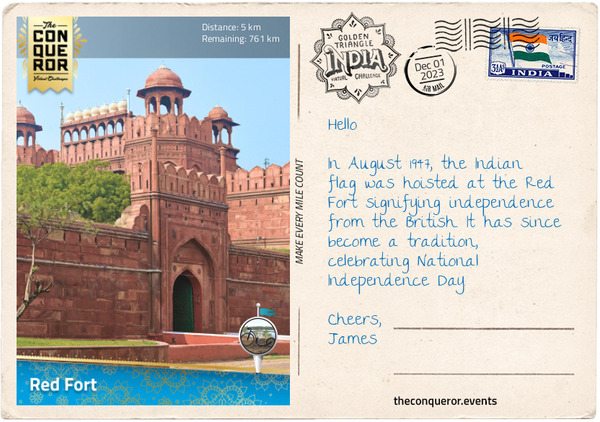
The Red Fort is on the right bank of the Yamuna River and is a walled palace inside Old Delhi. it became a UNESCO site in 2007. It was commissioned by the 5th Mughal Emperor, Shahjahan, who also built the Taj Mahal, in 1639 and took nine years to complete. The emperor’s main residence after he moved the capital from Agra, it is built of red sandstone and is a blend of Indian, Persian and Turk-Mongol elements. Historical records tell us that it was originally red and white in color, the outer walls being red and the buildings whithin those walls being white topped with bulbous domes. In 1739 invaders looted the fort removing it’s precious items and 120 years later the British demolished most of it’s marble structures.
The main entrance to the fort is via the Lahori Gate and a covered street market called Chhatta Chowk. Originally the street market was very exclusive as it provided such things as jewels, silk and brocade to the imperial household. A trail leads to the first of a number of buildings, called Naubat Khana, within it’s walls. It’s original purpose was to deliver legislative anouncements and play music numerous times a day, but today it houses a n archeological museum. Walking through it’s central archway along a path one reaches Diwan-i-Am, a multi-coloumned, multi-arched audience hall that was used by the emperors to meet the public.
Further along, behind the hall are three more buildings beside each other. The Rang Mahal functioned as the primary residence of the 5th emperor’s harem which became a mess hall under British rule. The Khas Mahal is a white marble palace that was the private residence of the emperor, and the third building is Diwan-i-Khas, his private audience hall. The hall was covered with precious stones and silver was used on it’s ceiling. Inside there was a peacock throne made of gold and precious stones with two decorative peacocks on top. It is claimed that it weighed over 1 metric tonne and cost twice as much as the Taj Mahal. When the Persians invaded and conquered the Mughal Empire in the 18th century, they realised how valuable the throne was and took it to Persia.. There is also a mosque called the Moti Masjid, built in 1659 by the 6th Mughal emperor Aurangzeb which looks austere on the outside but is beautifully decorated with archways, marble relief and floral motifs inside.
3rd December 2023 – Humayun’s Tomb
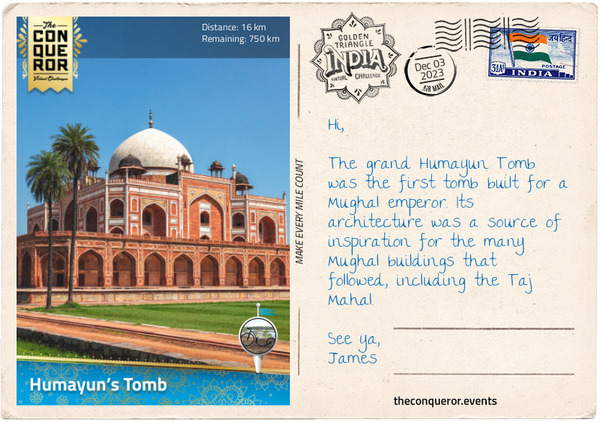
The route of the Golden Triangle travels south from the Red Fort to Raj Ghat, a memorial dedicated to Mahatma Gandhi who led a successful, non-violent campaign for India’s independence from British rule in 1947. There are several memorials to important people in India’s history within the Raj Ghat area including:
- Jawaharlal Nehru, India’s first prime minister and Mahatma’s political heir
- Indira Gandhi, Nehru’s daughter and no relation to Mahatma. She was India’s first female prime minister and was assassinated by her own Sikh bodyguards in 1984 as revenge for the deaths of hundreds of Sikhs killed as a result of gunfire between Indian troops and Sikh extremists.
- Rajiv Gandhi, Indira’s son who succeeded her and was also assassinated in 1991.
Diagonally opposite the Raj Ghat are the remains of a 14th century fort built during the Delhi Sultanate, which was an Islamic empire that occupied large parts of India between 1206-1526 AD before Mughals conquered them. The Jama Masjid mosque within it’s grounds is one of the largest and oldest mosques in India, and has Islamic and Hindu architectural elements in its Tughlaq. Every Thursday, large crowds gather to pray and write letters and it believed that supernatural genies (jinns) live in the fort who “descend from the Heavens” to “listen and help solve problems”.
The Humayun Tomb Park is the emperor Humayun’s final resting place. He met a sad end when he tripped on his robe while descending from upper floor and tumbled to his death. The tomb was commissioned by his first wife and is a symmetric structure, and the first example of a Persian garden tomb in India. The tomb sits at the “intersection of four water channels flowing in cardinal directions” within a square garden that’s supposed to represent paradise. Built of red sandstone, it has a marble dome and is decorated with inlaid work, black and white marble carvings and six-pointed stars as symbols of the cosmos. The tomb also houses the graves of his first and second wives, and his great-grandson Dara Shikoh, several succeeding emperors and over 100 Mughal family members. Dara Shikoh was killed by his brother Aurangzeb as a result of a bitter struggle for the throne. In 1993, The Park became a UNESCO site in 1993.
7th December 2023 – Truck Art
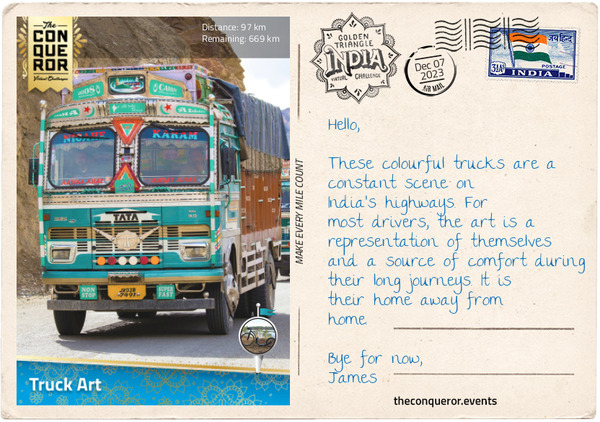
The distance between Delhi and Agra is long and is connected by a major highway. This could be rather monotonous and mundane, except for the constant stream of colourful trucks travelling on the highway. India’s economy is growing, and trucks play a crucial role in moving freight all over the country. Drivers spend weeks and even months on the road, their truck becoming their home where they cook, eat, and sleep. To make their nomadic lifestyle more pleasant, drivers paint their trucks inside and out. No two trucks look the same as the artwork on each truck is a very personal reflection of the driver’s personality, tastes, beliefs, and values as well as being a reminder of htheir ome and families.
Trucks were first introduced to India in the early to mid-20th century, when they were used to transport military freight. After the first and second World Wars, theose military passed into public for use. The camouflage painted trucks were too severe and drab a vibrant and colourful culture such as India’s, and provided their new owners with a blank canvas. Through the use of intense colours, popular phrases, images and accessories a new form of art evolved referred to simply as “truck art”. There is a whole industry dedicated to this artform with professional artists specialise in truck art becoming experts at it. Often, the truck artists are second or third generation truck artists. The artists have a distinctive style that is difficult to copy, especially the calligraphy that is written with precision and very steady hands. Prominent words such as ‘Horn Please’, is always in English and hand painted in a blocky 3D typeface. The colours are bright and saturated, rarely featuring black or neutrals. If black is used, it is usually only as a highlight an artistic detail.
Religious symbols, deities, national themes, peacocks (India’s national bird), eagles (signifying speed but always keeping the eye towards home), are some of the common features adorning the vehicles. ‘Nazar battu’, an evil looking a sharp-toothed demon with matted hair is an icon included on their trucks by drivers because it is believed to bring good luck, provide safe travels and ward off the evil-eye. While apparently superstituous it is seens as especially important given some of the treacherous roads and lengthy distances drivers must travel. A truck driver will cover up to 400km and drive 12 hours per day.
For long distance drivers, their well decorated trucks are a sense of pride, seen as being an extension of themselves and their home away from home.
On 12th December 2023 I reached the 20% completed point of the challenge.
13th December 2023 – Mughal Architecture
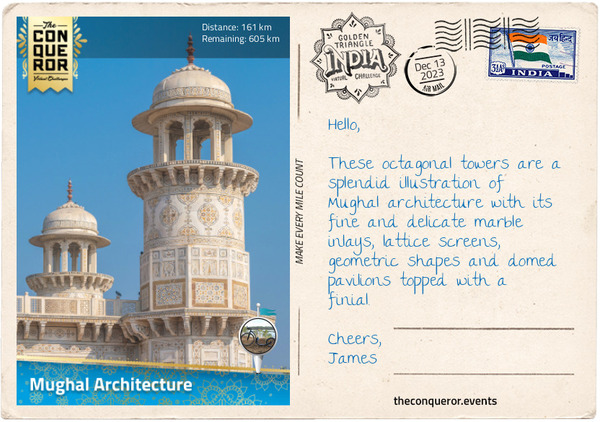
Mughal architecture is magnificent and is attributed mainly to four successive Mughal emperors: Akbar (3rd emperor), Jahangir (4th emperor), Shah Jahan (5th emperor) and Aurangzeb (6th emperor). Huge forts, Islamic mosques and mausoleums were all built within a century. Even though the Mughal empire existed for over 300 years and had as much as 20 emperors, very little was built after Aurangzeb. The vision of these few emperors left a richl legacy in monuments such as the Taj Mahal, Red Fort and Agra Fort.
Mughal architecture is a mixture of Islamic, Indian, Turkish and Persian styles using red sandstone and marble as the construction materials. It is characterised by symmetry, geometrical shapes and intricate details. Mughal buildings have pointed arches, massive vaulted gateways, minarets, bulbous domes, roofs lined with dome-shaped pavilions called ‘chhatri’ and windows protruding from the building’s wall called ‘jharokha’.
Mosques have large courtyards, while other buildings may be surrounded by gardens on all four sides. Walls are decorated Arabic scriptures, floral or geometric patterns inlaid in marble with semi-precious stones and perforated lattice screens in ornamental patterns, while ceramics, glass and mirrors may line the interiors. Mughal architecture does not feature representation of figurative images as doing so is forbidden in Islamic decoration so stylised flowers and naturalistic decorations as observed from nature are used instead.
The first major works were constructed during the reign of Akbar (1556-1605), who commissioned palaces, gardens, mosques and mausoleums designed by Persian architects. The buildings were huge monuments showcasing the power of the empire. Akbar’s grandson, Shah Jahan (1628-1658) had a keen interest in architecture and was the most prolific builder. Mughal architecture was at its peak during his reign.
Shah Jahan, unlike his father Aurangzeb (1658-1707) wasn’t as involved in architecture, his primary focus being on maintaining existing structures and royal tombs. But he did build several mosques including Badshahi Mosque which was the largest in the world at the time and is currently the second largest in the world. Aurangzeb also commissioned a tomb built for his wife which very much resembles the Taj Mahal.
After Aurangzeb’s death, the empire fell apart and in 1858 it was abolished by the British. As the empire disintergrated, the buildings and gardens were left neglected. Repairs done during the 20th century restored many of their monuments to their former glory, earning them a place on UNESCO’s World Heritage List.
17th December 2023 – Agra Fort
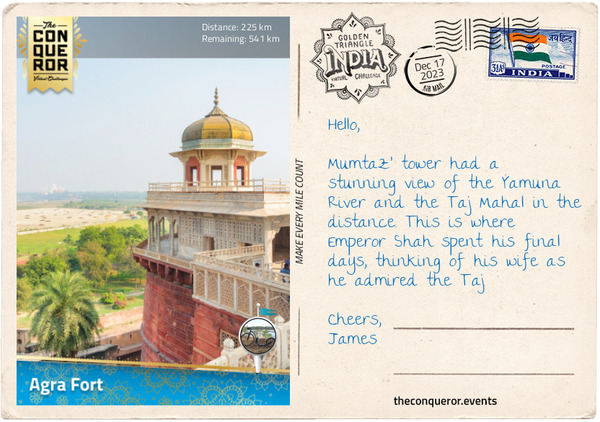
Coming into Agra, the first stop is at Itmad-ud-Daulah’s Tomb, which is a Mughal mausoleum built in the 1620s for Jahangir’s (4th emperor) Chief Minister and father-in-law. The tomb is set in a square walled garden with walkways and water channels criss-crossing in the same fashion as Humayun’s tomb. It was the first structure made completely out of marble and was beautifully ornamented with latticework and ‘parchin kari’, inlay techniques where gemstones were ‘cut and fit’ in the marble to create floral designs like a mosaic. There are six sided towers on each corner which are topped with dome-shaped pavilions. Instead of a central dome common to other Mughal buildings, it has a structure called ‘baradari’, a pavilion that has three arched openings on each side covered with latticework, except for the two entrances on the north and south side. Inside is a square hall housing the cenotaphs of the Chief Minister and his wife.
Crossing Yamuna River, one arrives at Agra Fort which was the Mughals’ former residence when Agra was the capital of the empire before the capital was moved to Old Delhi. It was built in the 1560s by Akbar (3rd emperor) and used as a military base and royal residence. The fort’s bastioned outer wall has a semi-circular shape with two entrances. The fort are several buildings of interest inside including the largest building, the Jahangiri Mahal. It was built by Akbar for his son, Jahangir, but was initially used as a palace for the women of the royal household and when Jahangir succeeded his father it was used by his wife, who was the mother of Shah Jahan. The Shish Mahal (The Glass Palace) was part of Shah Jahan’s summer palace which had inner walls and ceilings inlaid with thousands of small mirrors, twinkling in the semi-dark interior.
Near Shah’s private hall is a multi-storeyed, octagonal tower with a veranda that was used by his beloved wife Mumtaz Mahal. It’s marble surface was decorated with gemstone inlays, latticework and deep arched niches with a scented fountain featured in the centre of the room. It was here that Shah spent his last few years as a captive of his own son Aurangzeb, gazing at the Taj Mahal he had built in honour of Mumtaz as he lay on his deathbed.
The Agra Fort was added as a UNESCO site in 1983.
18th December 2023 – Taj Mahal
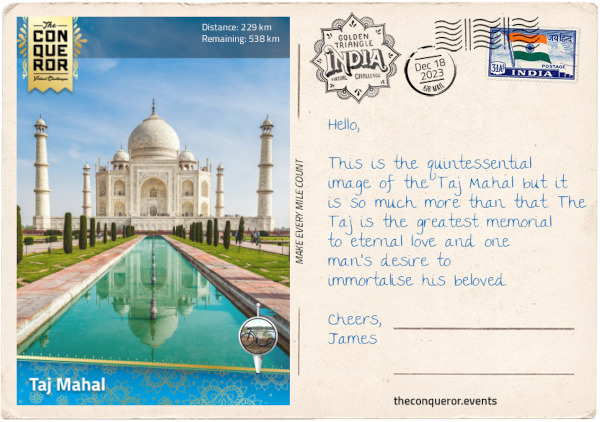
Less than 3.5km from the Agra fort is the magnificent and possibly most well known monument in all of India, the Taj Mahal. It was built by Shah Jahan over a period of 22 years, and is a memorial to Mumtaz Mahal, his favourite wife and companion of 19 years and the mother of his 14 children. They had a deep love affair that lasted throughout their entire marriage. She was his closest adviser, and travelled everywhere he went and even when he was exiled for a short time. She died in childbirth, leaving Shah in mourning for the remainder of his life.
Initially her body was buried near the Yamuna River and he would visit her grave regularly. One day he decided it was the ideal place to build her the grandest tomb, using marble from Makrana, about 320km to the west, which was transported in large blocks on carts pulled by buffaloes in teams of 20-30 beasts. At the site, earth ramps were built and ropes with pulleys were used to drag the stone to the top of the construction where masons were hired to fit the stones together and smooth the surfaces.
Over time, the building of the tomb became part of a much larger complex. The grand mausoleum was at the centre, sitting on a marble platform that was on top of a much bigger red sandstone plinth. The itself tomb was topped with four small domes and a massive central one shaped like a pearl. On the corners of the marble platform are four minarets, each 39m tall. Around the marble tomb are two identical red sandstone buildings while westward is a mosque while on the opposite side was a complementary building that was used for housing important guests.
The Taj has some of the most spectacular and intricate decorations in the world. Shah loved jewellery and often designed pieces for himself and wore them on his body and his turban. because of this he wanted the Taj to sparkle with gemstones which were inlaid in the form of flowers, especially tulips which were his favourite. Black marble was used to inlay calligraphy with quotes from the Quran. and inside the tomb are the cenotaphs of Shah and Mumtaz and at one time carpets and cushions were part of the decor.
In front of the Taj is a walled garden laid out in the usual quadrilateral design with water channels criss-crossing, suggesting paradise. At the centre was a large marble pool with fountains, representing the place where human and divine meet. Fruit trees and scented flowers were planted in the gardens creating a vibrant, aromatic atmosphere but there were replaced by the British with lawn.
The Taj Mahal was added to UNESCO’s list in 1983.
22nd December 2023 – Fatehpur Sikri
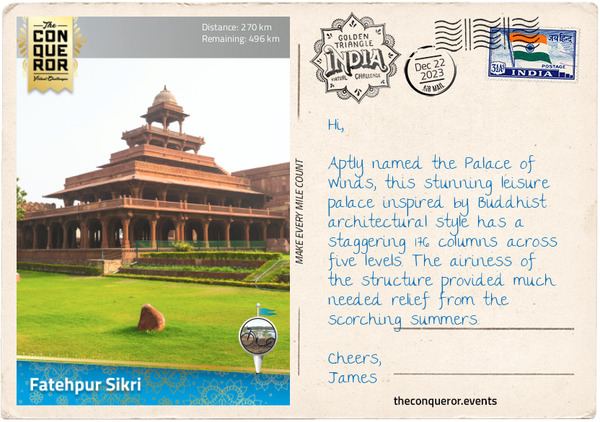
Heading west the Golden Triangle route brings me through the arched Agra Gate of the walled city of Fatehpur Sikri and then to Naubat Khana, a three-storey, three-arched drum house where a particular type of drum was played to announce the arrival of the emperor.
Fatehpur was built in the late 16th century by Akbar on the site where his son was born. He began by construction with a religious compound in honour of a Sufi saint called Salim Chisti who apparently predicted the birth of Jahangur, Akbar’s son. Imperial palaces, public buildings, mosques and walls for the city were later built, and it was established as the royal seat. Fourteen years later Akbar relocated to Lahore because he wanted to control unrest which was occuring in the northwest. Due to his long absence the city was left neglected. Later some maintenance was attempted but by the end of the Mughal empire the city was in a bad state. When the British set up an administrative centre and many of the monuments were repaired after 1803.
The most striking feature of Fatehpur is the very grand entrance to the Jama Masjid (a mosque), which is referred to as Buland Darwaza (High Gate) and was rebuilt by Akbar to celebrate the his success in one of his military campaigns. It is semi-octagonal structure standing 54m high with a central archway topped with a number of dome-shaped pavilions. On it’s walls are Persian inscriptions that describe Akbar’s conquests along with verses from the Quran. Forty-two steps lead up to the gateway.
Akbar was tolerant to other religion and at Fatehpur where he built the Ibadat Khana (House of Worship), where he aimed to gather spiritual leaders to discuss teachings of their various religions. being so intrigued by different teachings of those religions, he created his own religion, known as Din-i-llahi, which means “Religion of God” or “Divine Faith”. In his religion he intended to merge some of the best practices of all religions within his empire as a way of bringing reconciliation to the differenes that divied his subjects.
Most of the complex is built from red sandstone, but the Tomb of Salim Chisti located within the Jami Masjid is made of white marble and looks like ivory. It is built on a plinth that is decorated with geometric designs in black and yellow marble, and it’s walls are made entirely out of marble latticework. The is is richly adorned with floral inlays and geometric shapes. Verses from the Quran adorn the inner and outer walls of the tomb.
In 1986, Fatehpur Sikri was designated a UNESCO site. This is the fifth UNESCO location on this virtual journey.
On the 24th December I reached the 40% completed point of the challenge.
24th December 2023 – Keoladeo National Park
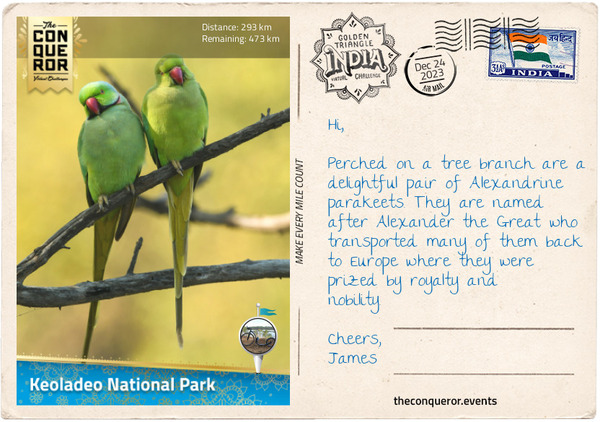
Before entering the city of Bharatpur one arrives at the Keoladeo National Park, a bird sanctuary and UNESCO site. This national park is 2,783ha in size and was established 250 years ago as a reserve for duck-hunting. In 1956 it became a sanctuary. The park has an incredibly diverse range of animals : more than 370 bird species (including permanent and migratory species), 380 species of plants, a number of snakes, lizards, turtles and amphibians. In it’s collection of bird species are some of striking appearance including the Saurus crane with its vibrant red head and grey body, a small wading bird with a fabulously large collar of ornamental feathers called the Ruff, and the vibrantly coloured Bee-eater. The park can be explored on foot or bike, as well as rickshaws. Taking a rickshaw ride also means the added benefit of the informative rickshaw acting as guides because they have been trained by the park’s management as the park’s management in bird spotting.
28th December 2023 – Holi Festival
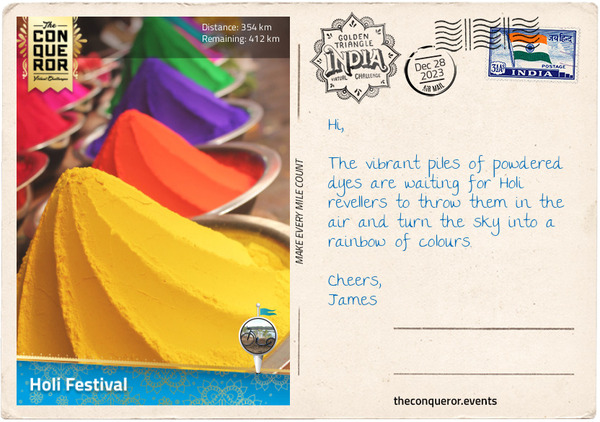
India is one of the most colourful places on earth and is known for the most vibrant and fun festival, known as Holi. it is celebrated each year at the start of spring and is a kaleidoscope of colour. It is a huge, playful event where family and friends take the time to have fun, be happy and welcome the start of spring and new beginnings and where people gather to toss powdered paint or coloured water at each other.
Holi is an ancient Hindu festival. It is believed that long ago there was an evil king who had a son called Prahlad and a daughter called Holika. The king received blessings from Brahma (God of Creation) and became so powerful that he forced his subjects and his children to worship him. Prahlad refused which made the king furious. The king, with Holika, hatched a plan to kill Prahlad by inviting him to sit in a pit of fire that Holika was immune to, hoping that he would burn to death. But Prahlad’s devotion to Brahma helped him walk away from the fire unhurt whilst Holika did not. The festival, named after her, signifies the triumph of good over evil.
In times past the colours used in Holi came from flowers and herbs but now they are synthetic. Vibrant red, yellow, green, blue, orange and purple colors are used while black and white are avoided. Each colour carries its own meaning. Red is the colour of marriage, fertility, love and beauty. Yellow is the color of turmeric which is an important ingredient known to have healing value for treating inflammatory and digestive ailments. Blue reveres the god Krishna, and green symbolises new beginnings and harvest. Saffron is associated with piety and strength.
Holi is a joyful event that binds people, regardless of their social standing, faith or spoken language, creating unity and friendship, an opportunity to end conflict, the chance to forgive and forget.
31st December 2023 – Dausa
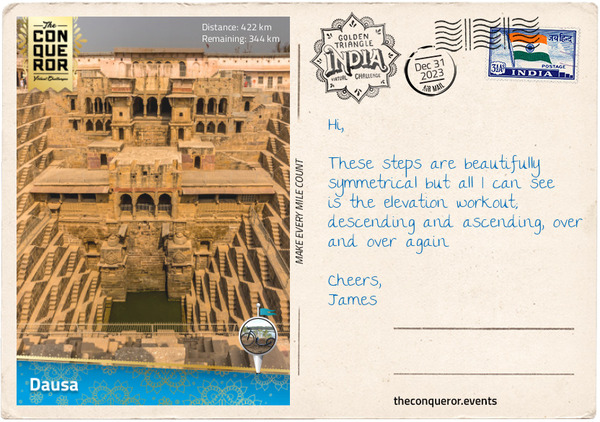
Dausa is a very old city that once served as the capital of the Dundhar region, a historical area in what is currently current Rajasthan, during the 10th and 11th century AD. It is the birthplace of a 17th century poet, philosopher and reformer of medieval India called Sant Kavi Sunderdas who wrote 48 books in several languages spoken during his life. Because of this his writings are widely accessible to people speaking various languagesa.
About 32km east of Dausa is the small village of Abhaneri which has magnificent stepwell, called the Chand Baori, which is the oldest, deepest and largest stepwell in India. The well was was built in the 8th century AD as a water reservoir and it was significantly added to in the 18th century AD. This makes it the only stepwell in India with two different building periods. The stepwell is a perfect square, 35m on each side and 30m deep, with 3,500 steps over 13 levels, on three sides of the well’s interior. The fourth side is a large temple over several levels. The lower sections were often used to escape the intense summer heat because at the bottom of the well is usually as much as 6°C cooler than on the surface. Around the perimeter is a colonnaded arcade that the Mughals added. Parts of the arcade were used as art galleries, which today display old sculptures and carvings that may have once decorated the interior of the temple.
Next to the stepwell is the Harshat Mata Temple, a ruined Hindu temple built around the 9th century AD. Not much of the original structure remains as it has been altered many times over the centuries. Many detailed stone carvings can be found around the main platform. Carvings of deities, flowers, peacocks and love scenes can be found on display. More historically valuable carvings have been moved to museums in Jaipur, which is my next stop.
On 5th January 2024 I reached the 60% completed point of the challenge.
7th January 2024 – Jaipur
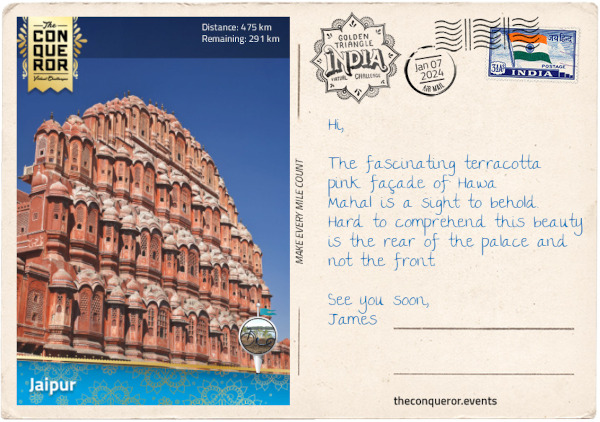
The city of Jaipur was the first planned city in India, established in 1727 when the Mughal empire was in decline. Compared with Old Delhi and Agra it is relatively young compared with and is known as the “Pink City”. Jai Singh II was the ruler of the Kingdom of Amber in the mountains,north of Jaipur. Due to water scarcity and relentless drought Jai Singh was forced to look for an alternative location on the plains at the base of the mountains. He was a keen mathematician, scientist and astronomer, who studied Europe’s cities and street plans. He hired a renowned Bengali architect and they began building the old city of Jaipur. He fortified the city with a wall. In 2019, UNESCO added the entire city on its World Heritage list. Most of the structures were built with white limestone and red brick powder, giving them a pinkish shade. When Prince Albert visited in 1876 Jai Singh arranged to have all the buildings painted in various shades of pink as a way of welcoming the prince. The colour pink is is beleived to symbolise hospitality. The tradition of keeping buildings pink continues to this day.
Within its fortified walls, Jaipur has a collection of beautiful monuments and eye-catching architectural styles. Those considered most important are:
- Jal Mahal Palace – a fantastic late 18th century palace situated in the middle of a lake which has a blend of Rajput and Mughal architecture in red sandstone . It was once used as a hunting lodge. It has the appearance of a single-storey floating palace but actually has five storeys, four of them being beneath the lake’s surface.
- Hawa Mahal Palace – is a pyramid shaped structure with the very intriguing façade. It is five storeys high and looks like a honeycomb of tiered bay windows decorated with latticework. It almost 1000 small windows and what is perhaps most surprising is that the façade is actually the rear of the palace. Now that is some detailed effort for the back of a building.
- Jantar Mantar – this is an astronomical observatory built in the 1720s, constructed from local marble. It is home to more than a dozen working astronomical instruments created to observe time, horoscopes and constellations. The most impressive one is the Samrat Yantra (the Supreme Instrument), which is one of the largest and still working sundials in the world. It features a 27m stairwell which makes a person feel as if they are climbing towards heaven. it has been a UNESCO site since 2010.
There are three exceptional forts which were used to defend the city: Nahargarh is just outside the city walls slightly northwest which provides uninterrupted views over Jaipur and was a good place to keep an eye out for potential threats; Amer is a fort of enormous proportions which is best appreciated from the lake below; and Jaigarh overlooks Amer Fort and Jaipur below. Jaigarh is home to the 18th century cannon-on-wheels that was the largest at the time of its manufacture, weighing 50 tonnes. In 2013, Amer was listed as a UNESCO site.
The history and architecture in Jaipur are immensely rich. It would take quite some time to explore it in its entirety.
12th January 2024 – Bengal Tiger
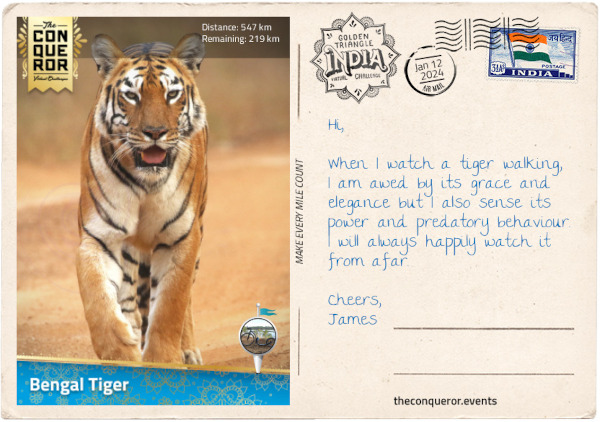
One cannot describe India without making mention of the Bengal Tigers. These gorgeous and impressive beasts have dwindled dramatically in numbers in recent decades, due mostly to poaching, destruction of their habitat and conflicts between humans and tigers. The sorry state of these animals has reached such an extent that it now has its own annual international day – 29th July. The purpose of this international day of recognition is to advocate for the conservation of these tigers and their natural habitats. The tiger is India’s national animal and the country has engaged in conservation of it’s tiger population since 1973.
India is home to 80% of the earth’s tigers, but there are estimated to be less than 3,000 of them left in India. There are over 50 tiger reserves across India, the closest one on this virtual journey being the Sariska Tiger Reserve. Early in the 20th century it was a hunting preserve, later being declared a wildlife sanctuary, and by 1982 it had become a national park with a specific focus on preserving tigers.
Early in the 2000s there were approximately 25 tigers in the reserve, but due to the actions of poachers the population was decimated over a 5 year period. A relocation program was started in 2008, with two tigers being transferred from a different park. A year later, another was transferred, and by 2020 there were 20 tigers on the reserve. Sariska was the first reserve that was successful in having tigers relocated to it.
India puts an huge effort into conservation having committed substantial funding for the program and has established a Special Tiger Protection Force especially trained to combat poaching. Let’s hope their efforts pay off so people today and future generations and can continue seeing these beautiful animals roam in their natural habitat.
On 16th January 2024, I had completed 80% of the challenge.
18th January 2024 – North Indian Cuisine
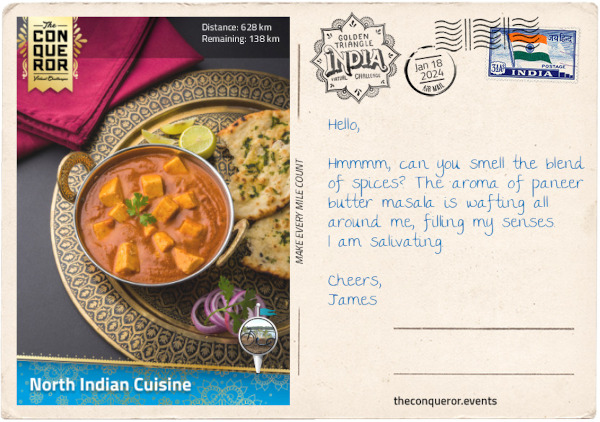
Because India is such a multi-cultural and multi-ethnic country there is no single specific cuisine that can be identified as especially Indian. It’s cuisine is as diverse as its languages, architecture or faiths. The Golden Triangle being located in North India, it is worth considering the food of Northern India. There are a number of cuisine types.
There are the Mughlai and Rajasthani cuisines. Mughlai cuisine goes as far back as the Indo-Persian era with recipes that are strongly influenced by Turkic foods, the Mughals originated from. The dishes are rich in taste and aroma being enhanced with spices such as saffron, cardamon, black pepper and cumin.
An example of such a food is Tikka, a Mughlai dish made up of skewered boneless pieces of meat marinated in spices and yoghurt which is then cooked in clay ovens. It’s origins are unknown, but the Mughals did bring boneless pieces of meat that they called Tikka to India. Various spices are used in it’s preparation such as red chilli, turmeric, pepper, coriander and garam masala. The flavour of this dish is a combination of spiciness, with warm and earthy flavouring from the turmeric and a citrus like aroma from coriander.
Rajasthani cuisine is of interest because it was based on the ingredients that were available in a very parched environment. Because of the war-like lifestyle at the time it was important that the food would last for a number of days and be eaten without requiring heating. Another challenge was the lack of vegetables, meaning that most of the people in the region were non-vegetarians. This is interesting because today 75% of its population is vegetarian, making it the largest vegetarian state in India.
One dish that is vegetarian is Daal Baati, a lentil curry with hard wheat rolls. Lentils are often considered to be rather bland by themselves (although I personally like them like that) but when combined with such spices as cumin, ginger, asafoetida, green chili, turmeric, garam masala and chilli powder, it is transformed into a pleasurable, warming and spicy experience. The Daal (also spelt dal, dahl, or dhal) in the dish’s name is the lentil and spices. The Baati in the dish’s name is a hard unleavened bread which is a bit more labour intensive to prepare but has a long shelf life, is very nutritious and requires a minimal quantity of water to make. This dish was highly prized during wartime and in desert areas.
As with any food dish, the preparation is often at the whim of the person making it. I have made Daals before, and no two of them are exactly the same – my cooking style is very much one of improvisation. Spices may vary somewhat, cooking approaches may differ giving the lentils a different consistency, variations can abound but in the end if the dish is pleasurable to the senses and of good nutritional value then it doesn’t matter exactly how it was made or where it’s ingredients came from.
During this challenge, I would sometimes make a lentil and nut curry on toast for breakfast after my longer (30+km) Sunday morning Kickbike rides – it probably wouldn’t be considered a real Daal Baati, but is somewhat similar in concept I suppose. As well as the lentils and peanut sauce (which made by hand, from home made roasted and salted peanut and cashew butters), I would add curry, cumin, maybe some tumeric, and then various herbs and other spices as the mood took me. Then I would toast some home made bread (also made by me) and put the Daal on top. A very delicious and filling breakfast after a long ride.
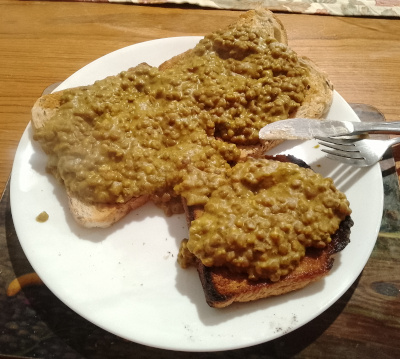
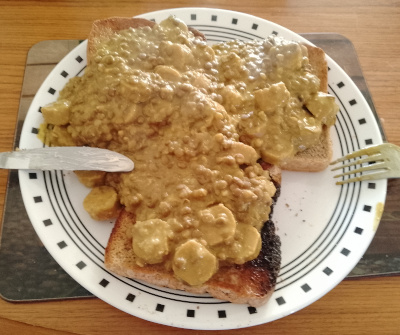
26th January 2024 – Qutb Minar, and Delhi
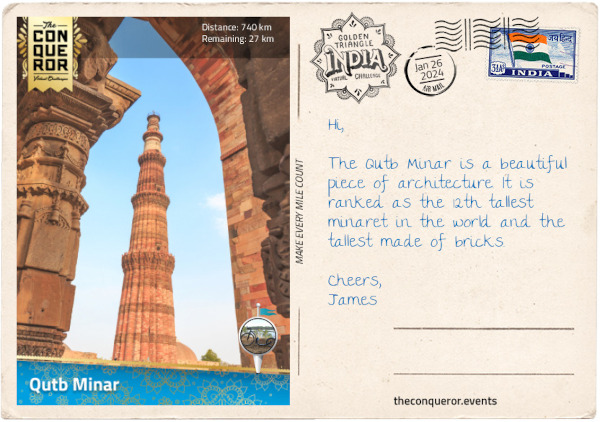
After a journey of more than 700km, I’m back in Delhi with only 26km to complete the challenge.
A visit to Qutb Minar is the last place of itnerest before Delhi and the completion of the challenge. The minaret 73 metres high and was built by the first ruler of the Delhi Sultanate, a dynasty that ruled efore the Mughals. Construction began in the late 12th century and over the centurues it was added to, repaired and restored often by many different rulers. Earthquakes in 1505 and 1803 caused substantial damage to it. When it was renovated in 1828, a pillared cupola was added on the top floor but 20 years later the Governor General of India had it removed because he thought it looked out of place. That cupola is now located on the nearby grounds.
Minarets are a feature of Islamic architecture and are nearly always connected to a mosque. They usually have one or more balconies from where Muslims are called to prayer by a muezzin (a crier). But the Minar is a stand-alone structure used for the same purposes. It has inscriptions on it indicate that it may have also served as a “victory tower”.
The monument is five storeys high, separated by balconies that are richly carved with inscriptions from the Quran. The bottom three levels are made of red sandstone and the top two are a combination of sandstone and marble. The Minar is a tapering tower, with a base having a diameter of 14 metres and the top 2.75 metres, and a stairwell consisting of 379 steps.
Next to the Minar is Quwwat-ul-Islam Masjid, the first mosque ever built in India and the oldest surviving example of Ghurids architecture. The Ghurids were a dynasty originating in Iran around the 11th century AD. It has been claimed that the columns used to erect the cloisters were the result of demolishing 27 Hindu Temples as a result of following a direct order from the ruler at that time. This proved to be a major problem because the Hindu columns had to be adapted to Islam’s forbidden use of images in sacred buildings. So the masons covered the columns with plaster and probably decorated them with geometric patterns. Over the centuries that followed the plaster fell off, revealing the original and highly-detailed Hindu carvings.
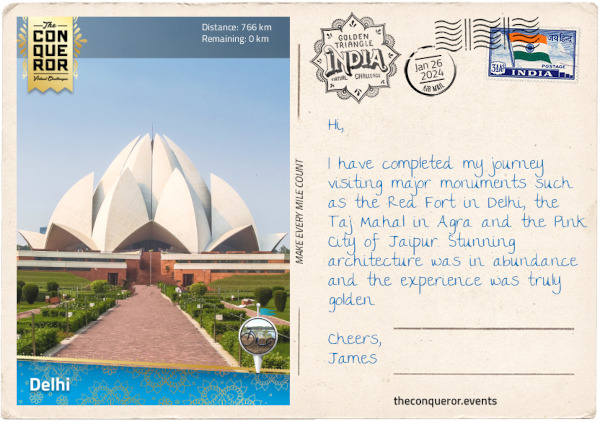
About 11km north of Qutb Minar is the Tomb of Safdar Jang who became Prime Minister of India in 1748, during the reign of the Mughal Empire. He was dismissed after five years later and died a year after that. His son pleaded with the Emperor to allow him to tomb in honour of his father. The monument was the last Mughal garden tomb built.
Across from the eastern corner of Buddha Jayanti Park is a large statue of Gandhi and his followers. The massive black sculpture represents Gandhi’s iconic non-violent march in 1931 against the exorbitant salt tax imposed on India by the British.
Continuing north I go through the Kamla Nehru Park to visit the Mutiny Memorial that was erected in memory of those who fought during the Indian Rebellion of 1857. The memorial was built quickly of red standstone in a gothic style in 1863. It received a lot of criticism possibly because it didn’t look like or complement the Indo-Islamic architecture found throughout the city of Delhi.
A few hundred metres away is the Ashoka Pillar which is very old, having been erected in the 3rd century BC by King Ashoka who converted to Buddhism and used the pillar, along with many others in India, to inscribe Buddhist edicts and spread his Buddhist faith throughout the country. The pillar is made out of one large block of sandstone that was cut, dressed, polished into a circular column and inscribed with the edicts. The pillar was blown apart into 5 pieces by an explosion in 1719 and remained that way until the mid-19th century when it was repaired and re-erected. because of this it resembles a 3D jigsaw puzzle pieced back together with heavy mortar.
On 26th January 2024, I completed the Golden Triangle virtual challenge.
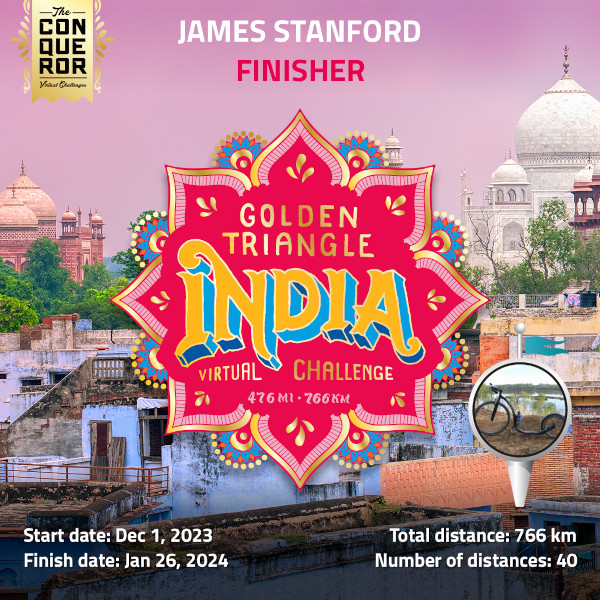
Statistics:
Length: 766km.
Days to complete: 55.
Number of rides: 40.
Avg ride length: 19.15.
Having completed virtual fitness challenges over the last few years by bicycle or kickbike in Asia (Nakasendo Trail, Golden Triangle), Europe (Romantic Road, St Francis Way and Camino de Santiago), and the British Isles (Lands End to John O’Groats, North Coast 500), I’m thinking I would like to do a challenge in the Americas next (maybe even one in the north and one in the south). But which one/s to choose… That’s for a future blog post.
You May Also Like

One Comment
Elaine Stanford
Another interesting Blog, James.
Love, Mum